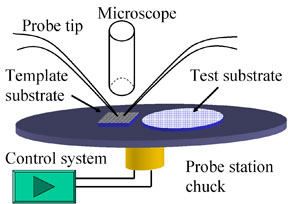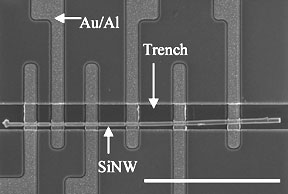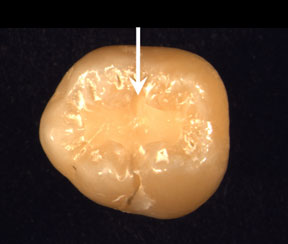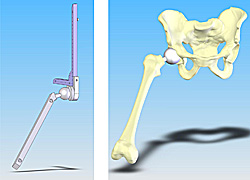| April 26, 2007

[NIST Tech Beat Search] [Credits] [NIST Tech Beat Archives] [Media Contacts] [Subscription Information]

Placing Single Nanowires: NIST Makes the Connection
 |
 |
(a) Schematic of NIST single nanowire manipulation system.
(b) Scanning electron microscope image shows a single silicon nanowire positioned in an etched trench using NIST's nanowire manipulation technique. The trench helps keep the nanowire in position during the fabrication of the rest of the test structure, which measures metal/nanowire contact resistance. The scale bar is 20 micrometers long.
Credit: NIST
View hi-resolution image (top)
View hi-resolution image (bottom) |
Researchers at the National Institute of Standards and Technology (NIST) have devised a system for manipulating and precisely positioning individual nanowires on semiconductor wafers. Their technique, described in a recent paper,* allows them to fabricate sophisticated test structures to explore the properties of nanowires, using only optical microscopy and conventional photolithographic processing in lieu of advanced (and expensive) tools such as focused ion or electron beams.
Nanowires and nanotubes are being studied intensively as essential elements for future nanoscale electronics, but some fundamentals remain to be worked out—among them, how to put wires only a handful of atoms in diameter where you want them. The smallest-diameter nanowires today are built in a “bottom-up” fashion, assembled atom-by-atom through a chemical growth process such as chemical vapor deposition. This is essentially a bulk process; it produces haystacks of jumbled nanowires of varying lengths and diameters. “The normal research approach,” explains NIST electronics engineer Curt Richter, “is to throw a whole bunch of these down on the test surface, hunt around with a microscope until you find a good-looking wire in about the right place, and use lithography to attach electrical contacts to it.”
To achieve better control, the NIST engineers modified a standard probe station used to test individual components in microelectronic circuits. The station includes a high-resolution optical microscope and a system for precisely positioning work surfaces under a pair of customized titanium probes with tips less than 100 nanometers in diameter. In a two-step process, silicon nanowires suspended in a drop of water are deposited on a special staging wafer patterned with a grid of tiny posts, and dried. Resting on the tops of the posts, selected nanowires can be picked up by the two probe tips, which they cling to by static electricity. The test structure wafer is positioned under the probes, the nanowire is oriented by moving either the probe tips or the wafer, and then placed on the wafer in the desired position.
Although not at all suited to mass production, the technique’s fine level of control allows NIST engineers to place single nanowires wherever they want to create elaborate structures for testing nanowire properties. They’ve demonstrated this by building a multiple-electrical-contact test structure for measuring the resistance of a nanowire independent of contact resistance, and a simple electromechanical “switch” suitable for measuring the flexibility of nanowires. They’ve used the technique successfully with nanowires greater than about 60 nm in diameter, and say sharper probe tips and high-resolution microscopes could push the limit lower.
*Q. Li, S. Koo, C.A. Richter, M.D. Edelstein, J.E. Bonevich, J.J. Kopanski, J.S. Suehle and E.M. Vogel. Precise alignment of single nanowires and fabrication of nanoelectromechanical switch and other test structures. IEEE Transactions on Nanotechnology. V.6, No.2. March 2007.
Media Contact: Michael Baum, michael.baum@nist.gov, (301) 975-2763 

New Nanocomposites May Mean More Durable Tooth Fillings
 |
A calcium phosphate nanocomposite filling in a tooth. The nanocomposite can "smartly" release decay-fighting agents to buffer against acids produced by bacteria, and rebuild the lost tooth minerals by releasing ions into the mineral-deficient area of the tooth.
Credit: NIST
View hi-resolution image |
The mouth is a tough environment—which is why dentists do not give lifetime guarantees. Despite their best efforts, a filling may eventually crack under the stress of biting, chewing and teeth grinding, or secondary decay may develop where the filling binds to the tooth. Fully 70 percent of all dental procedures involve replacements to existing repairs, at a cost of $5 billion per year in the United States alone.
Now, however, scientists at the American Dental Association’s Paffenbarger Research Center, a joint research program at the National Institute of Standards and Technology (NIST), have shown that nanotechnology has the potential to lessen that toll by producing tooth restorations that are both stronger than any decay-fighting fillings available today, and more effective at preventing secondary decay. They report their findings in a recent issue of The Journal of Dental Research.*
The researchers’ new technique solves a problem with the standard composite resin filling, a natural-looking restoration that is the method of choice when appearance is an issue. A dentist creates the filling by mixing the pure liquid resin with a powder that contains coloring, reinforcement and other materials, packing the resulting paste into the cavity, and illuminating the tooth with a light that causes the paste to polymerize and harden. For decay-fighting composite fillings, the problem arises from an additive that is included in the powder to provide a steady release of calcium and phosphate ions. These ions are essential to the long-term success of the filling because they not only strengthen the crystal structure of the tooth itself, but buffer it against the decay-causing acid produced by bacteria in the mouth. Yet the available ion-releasing compounds are structurally quite weak, to the point where they weaken the filling as a whole.
To get around this conundrum, the Paffenbarger researchers have devised a spray-drying technique that yields particles of several such compounds, one of which being dicalcium phosphate anhydrous, or DCPA, that are about 50 nanometers across—20 times smaller than the 1-micrometer particles in a conventional DCPA powder. Because these nanoscale particles have a much higher surface to volume ratio, they are much more effective at releasing ions, which means that much less of the material is required to produce the same effect. That, in turn, leaves more room in the resin for reinforcing fibers that strengthen the final filling. To exploit that opportunity, the Paffenbarger researchers also have developed nanoscale silica-fused fibers that produce a composite resin nearly twice as strong as the currently available commercial variety.
* H.H.K. Xu, M.D. Weir, L. Sun, S. Takagi and L.C. Chow. Effects of calcium phosphate nanoparticles on Ca-PO4 composite, J Dent Res 86(4):378-383m 2007.
Media Contact: Michael E. Newman, michael.newman@nist.gov, (301) 975-3025 

NIST Measuring Device Aims to Up Hip Operation Success
 |
NIST prototype hip replacement 'phantom' (l.) provides a precisely measured coordinate system and magnetic ball and socket joint to calibrate and to measure the clinically relevant performance of Computer Assisted Orthopaedic Surgery (CAOS) tracking instruments used in delicate operations to install artificial hip joints (r.).
IImage credit: NIST
View hi-resolution image |
Researchers at the National Institute of Standards and Technology (NIST) are developing state-of-the-art measuring techniques, similar to those used in making aerospace components fit together precisely, that soon could improve success rates for hip replacement surgery. At the request of a group of prominent orthopaedic surgeons and the American Academy of Orthopaedic Surgeons (AAOS), the NIST researchers are working to improve calibrations and operating room testing of the Computer Assisted Orthopaedic Surgery (CAOS) tracking instruments surgeons use to plan the delicate, highly complex operation.
To be completely successful, CAOS hip replacement surgery must take into account tiny human skeletal differences. Imprecise measurements, which could result from conditions seemingly unrelated to the surgery, such as operation room noise or temperature, can lead to poor positioning of implants, leaving some former patients with discomfort during walking and, in rarer cases, a need to redo the operation.
The researchers have built a lightweight device called a “phantom” that resembles the artificial socket, ball and femur substitutes that surgeons use to replace the joint and bone in hip operations, based on a calibrated XY coordinate frame. They drilled tiny holes at precisely measured intervals into the phantom and made cuts at precisely measured angles, favored by surgeons for CAOS operations. Because the precise coordinates of the mechanical (magnetic) ball and socket joint center of rotation have been measured, manufacturers of CAOS tracking sensors can use the phantom to test the accuracy of their measuring instruments. Surgeons also should be able to test the accuracy of their CAOS devices, just before making their first incision, to measure ball and socket joint center of rotation coordinates, angles for cuts into the bone and places for the insertion of screws
Currently, no standardized approach to the evaluation of CAOS technology exists, but an ASTM International committee is working on the establishment of such standards. In the coming months NIST will submit its hip CAOS phantom to orthopaedic surgeons for review. Clinical trials could follow. If the device wins Federal Drug Administration (FDA) approval, it can be expected to find its way into operating rooms across the country and world. The researchers look forward to extending the application of the technology to surgical procedures on the knee and shoulder.
Media Contact: John Blair, john.blair@nist.gov, (301) 975-4261 

NIST Issues Guidelines for Ensuring RFID Security
Retailers, manufacturers, hospitals, federal agencies and other organizations planning to use radio frequency identification (RFID) technology to improve their operations should also systematically evaluate the possible security and privacy risks and use best practices to mitigate them, according to a report* issued today by the National Institute of Standards and Technology (NIST).
“RFID tags, commonly referred to as smart tags, have the ability to improve logistics, profoundly change cost structures for business, and improve the current levels of safety and authenticity of the international pharmaceutical supply chain and many other industries,” said Under Secretary of Commerce for Technology Robert C. Cresanti. “This important report lays the foundation for addressing potential RFID security risks so that a thoughtful enterprise can launch a smart tag program with confidence.”
RFID devices send and/or receive radio signals to transmit identifying information such as product model or serial numbers. They come in a wide variety of types and can be as small as a grain of rice or printed on paper. Unlike bar coding systems, some RFID devices can communicate without requiring a line of sight, and over longer distances, for faster batch processing of inventory. They can be outfitted with sensors to collect data on temperature changes, sudden shocks, humidity or other factors affecting products.
However, as RFID devices are deployed in more sophisticated applications from matching hospital patients with laboratory test results to tracking systems for dangerous materials, concerns have been raised about protecting such systems against eavesdropping and unauthorized uses. The new NIST report focuses on RFID applications for asset management, tracking, matching, and process and supply chain control. It lists of recommended practices for ensuring the security and privacy of RFID systems, including firewalls that separate RFID databases from an organization’s other databases and information technology (IT) systems, encryption of radio signals when feasible, shielding RFID tags or tag reading areas with metal screens or films to prevent unauthorized access, and other security measures.
Two case studies—in health care and supply chain settings—provide examples for identifying and minimizing security risks throughout the various stages of an RFID project.
For more details, see: www.nist.gov/public_affairs/releases/rfidsecurity.html
*T. Karygiannis, B. Eydt, G. Barber, L.Bunn and T. Phillips. Guidelines for Securing Radio Frequency Identification (RFID) Systems (Special Publication 800-98), 154 pages. Available on-line at http://csrc.nist.gov/publications/nistpubs/800-98/SP800-98_RFID-2007.pdf.
Media Contact: Gail Porter, gail.porter @nist.gov, (301) 975-3392 

Nano Structures Can Pose Big Measurement Problems
Materials scientists will tell you that to best understand, characterize and eventually utilize the properties of a specific material, you have to be able to define how the atoms within it are arranged. In the case of common crystals, there are numerous methods, such as X-ray diffraction, by which this can be done. Not so for nanostructured materials (structures with atomic arrangements at a scale of 1-100 nanometers, or between 5 to 1,000 atoms in size) where the inability to determine atomic order with high precision has been dubbed the “nanostructure problem.”
In a paper published in the April 27 Science,* researchers Igor Levin at the National Institute of Standards and Technology (NIST) and Simon J.L. Billinge at Michigan State University reviewed various classes of nanostructured materials, listed the array of methods currently used to study their atomic makeup and defined the problems inherent with each one. Overall, the authors state that while many methods exist for probing the atomic structure on the nanoscale, no single technique can provide a unique structural solution.
The authors conclude their paper by calling for a coordinated effort by researchers to develop a coherent strategy for a comprehensive solution of the “nanostructure problem” using inputs from multiple experimental methods and theory.
* S.J.L. Billinge and I. Levin. The problem with determining atomic structure at the nanoscale. Science, 316: 5823, April 27, 2007.
Media Contact: Michael E. Newman, michael.newman@nist.gov, (301) 975-3025 

DVD Showcases 2006 Baldrige Award Winners
A new DVD can help large and small companies, educational and health care organizations, and non-profit organizations learn about the outstanding management practices and successful strategies of the three recipients of the 2006 Malcolm Baldrige National Quality Award.
The DVD contains separate, in-depth looks at Premier Inc. (service category, San Diego, Calif.); MESA Products Inc. (small business category, Tulsa, Okla.); and North Mississippi Medical Center (health care category, Tupelo, Miss.) with each video featuring extensive interviews with chief executives. Also included on the DVD are a composite video showcasing all three recipients and a video of the Baldrige Award ceremony held on March 13, 2007.
The DVD may be purchased for $35.00 plus shipping and handling from the American Society for Quality, P.O. Box 3005, Milwaukee, Wis. 53201-3005, (800) 248-1946. Use order number T1516. Other Baldrige National Quality Program materials—including the criteria for performance excellence for business, education, health care and non-profits—also are available.
The Baldrige Award is given to businesses—manufacturing and service, small and large—and to education, health care and non-profit organizations that apply and are judged to be outstanding in seven areas: leadership; strategic planning; customer and market focus; measurement, analysis and knowledge management; human resource focus; process management; and results. The award is managed by NIST in conjunction with the private sector.
For more information, go to www.quality.nist.gov.
Media Contact: Michael E. Newman, michael.newman@nist.gov, (301) 975-3025 

Quick Links
Earthquake Hazards Meeting at NIST, May 10-11
The National Earthquake Hazards Reduction Program (NEHRP) Advisory Committee on Earthquake Hazards Reduction (ACEHR) will meet May 10 and May 11 at the National Institute of Standards and Technology (NIST) laboratories in Gaithersburg, Md.. The committee will assess trends and developments in the science and engineering of earthquake hazards reduction; the effectiveness of NEHRP in performing its statutory activities in improving design and construction methods and practices, land use controls and redevelopment, prediction techniques and early-warning systems; coordinated emergency preparedness plans and public education and involvement programs; any need to revise NEHRP; and the management, coordination, implementation and activities of NEHRP.
Interested parties who would like to offer comments and suggestions related to ACEHR affairs are invited to request a place on the agenda. On May 10, approximately one-half hour will be reserved for public comments and speaking times will be assigned on a first-come, first serve basis. Speakers who wish to expand on their oral statements, those who had wished to speak but could not be accommodated on the agenda and those who were unable to attend in person are invited to submit written statements to the NEHRP Advisory Committee, NIST, 100 Bureau Drive, MS 8610 (ATTN: T. Faecke), Gaithersburg, MD 20899-8610, via fax at (301) 975-4032, or by e-mail to info@nehrp.gov.
Anyone interested in attending the meeting must pre-register by May 3. Registrants should submit their name, time of arrival, e-mail address and phone number to Amber Stillrich at amber.stillrich@nist.gov or by phone: (301) 975-3777. Non-U.S. citizens also must submit their country of citizenship, title, employer/sponsor and address. Information on NEHRP and the ACEHR is available at http://nehrp.gov/.
NIST Official Honored as Standards Champion
James Hill, recently retired acting deputy director of NIST and former director of NIST’s Building and Fire Research Laboratory, has been selected as the 2007 recipient of the Ronald H. Brown Standards Leadership Award. The award, named after the late U.S. Secretary of Commerce, is presented annually during the U.S. Celebration of World Standards Day in October. Hill is being honored for his leadership of NIST building and fire research that has lead to numerous major safety enhancements for U.S. building codes and standards, and improved fire safety and emergency response practices. For more, go to www.ansi.org/news_publications/news_story.aspx?menuid=7&articleid=1466.
|

